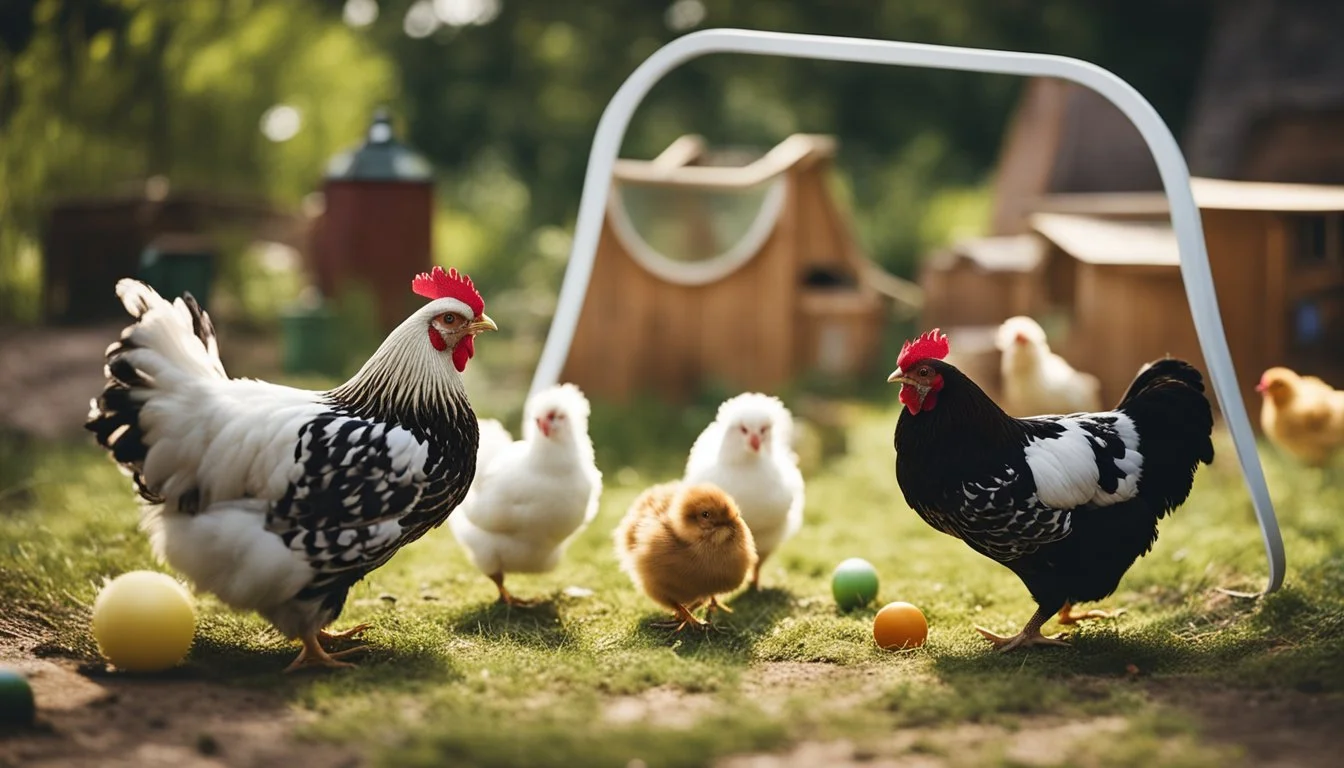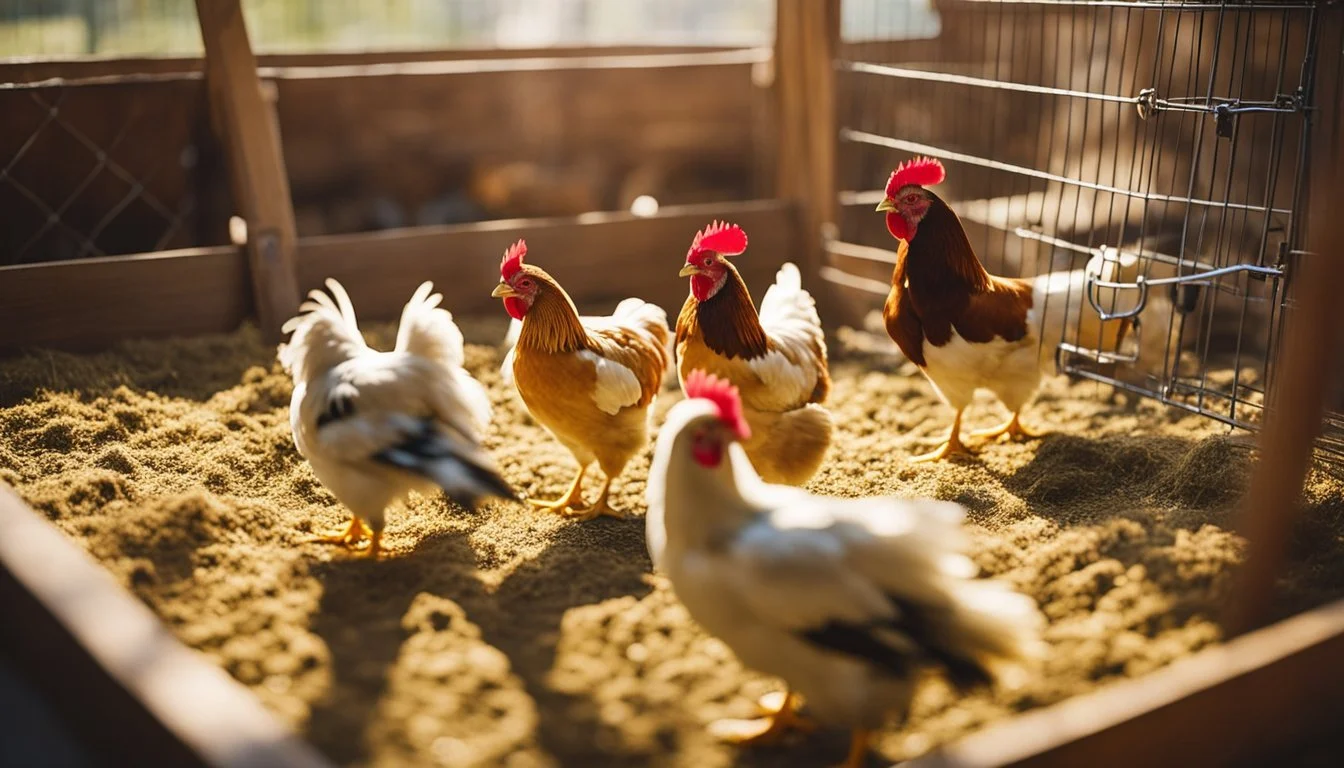5 DIY Chicken Toys to Keep Your Flock Entertained
Boosting Backyard Fun
Keeping chickens entertained is essential for their well-being, reducing stress, and promoting healthy behavior. Many chicken owners turn to DIY solutions as an affordable and customizable way to enrich their flocks' environment.
By creating engaging and stimulating toys, anyone can provide their chickens with essential physical and mental exercise. Whether it's through the use of simple household items or more crafted toys, there's a vast array of possibilities that can cater to any flock's preferences.
1) Homemade Treat Dispenser
A homemade treat dispenser can keep chickens entertained and mentally stimulated. To make one, start with a clean plastic water bottle.
Use a sharp knife or drill to create small holes. The holes should be just large enough for the treats to pass through. Popular treats include seeds, mealworms, and small pieces of fruit.
Next, thread sturdy rope through the bottle's cap and tie a knot to secure it. Hang this treat dispenser in the chicken run at a height that is accessible for pecking.
As the chickens peck at the dispenser, treats will fall out. This encourages natural foraging behavior and provides physical activity. Rotate the treats regularly to maintain their interest.
Homemade treat dispensers are not only cost-effective but also easy to customize. By adjusting hole sizes and varying treat types, the chickens can experience different challenges and rewards.
Creating these DIY feeders can significantly reduce boredom and unwanted behaviors like feather pecking. Adding such enrichment tools can contribute to a healthier, happier flock.
2) Hanging Vegetable Basket
A hanging vegetable basket can be a great way to entertain your chickens while ensuring they get a nutritious treat.
To create this toy, use a sturdy basket and fill it with a variety of fresh vegetables like carrots, cucumbers, and lettuce.
Securely hang the basket in the chicken coop or run at a height that is accessible for your flock.
The chickens will peck at the hanging vegetables, keeping them occupied and providing mental stimulation.
Additionally, it promotes physical activity as they stretch and jump to reach their treat.
Ensuring the basket is durable and securely fastened is crucial to prevent it from falling and causing harm to the chickens.
Rotate the types of vegetables to keep the activity interesting and balanced for your flock's diet. This simple DIY toy can help reduce boredom and encourage natural foraging behaviors among your chickens.
3) Chicken Swing
A chicken swing is a delightful addition to any coop. Chickens find it entertaining and amusing, creating a lively atmosphere in their living space. It’s an effective way to keep them active and engaged throughout the day.
Creating a chicken swing is simple. You need a sturdy piece of wood or a wooden dowel and some durable rope. Secure the wood to the rope and hang it at a suitable height for your chickens to hop on.
Ensure the swing is well-balanced to avoid startling the birds. Place it in a shaded or partially covered area to protect the chickens from direct sunlight while they play.
Observing chickens on a swing can be quite enjoyable. It not only provides physical stimulation but also mental enrichment. This helps reduce boredom and stress in the flock, promoting overall health and well-being.
Chicken swings are particularly useful in keeping confined chickens happy. They provide an outlet for natural behaviors and movements, such as perching and balancing. In turn, this can lead to healthier, more content birds.
4) Pecking Ball
A pecking ball is a fantastic way to keep chickens entertained and mentally stimulated. This DIY toy can be made using simple materials like a small, sturdy ball and some rope.
To create a pecking ball, choose a tough, piercing-resistant ball, such as a rubber dog toy or a plastic ball with holes.
Insert treats like vegetables, fruit pieces, or grains into the ball. Securely attach a rope to the ball, ensuring it can hang freely and move when pecked.
Hang the pecking ball in the coop or run, at a height convenient for your chickens to reach. As they peck at the ball to get the treats, they engage in natural foraging behavior, which helps reduce boredom and stress.
Rotate the types of treats inside the ball to keep the chickens interested and engaged. This variety will stimulate their foraging instincts and provide much-needed physical activity.
A pecking ball is a versatile and inexpensive way to promote healthy behaviors in your flock. With minimal effort, it enhances their environment and keeps them active and happy.
5) Mirror Toy
Mirrors can be a simple yet engaging toy for chickens. Chickens are naturally curious and can be intrigued by their own reflections.
A small, securely fastened mirror in the coop or run can provide hours of entertainment. Chickens may peck at their reflection or even perform little dances.
It's essential to regularly check the mirror for cracks or sharp edges. Safety should always be a priority to prevent any injuries.
Using a shatterproof mirror is the best choice. These mirrors can withstand pecking and scratching without breaking into dangerous pieces.
Hanging the mirror at the chickens' eye level ensures they can easily see their reflections. They may interact with the mirror more frequently if it’s easy to access.
Mirrors can also be used to make a coop appear more spacious. This can help reduce stress among chickens, especially in smaller spaces.
Benefits of DIY Chicken Toys
DIY chicken toys offer several advantages, including promoting physical activity, providing mental engagement, and leading to improved behavior in your flock.
Physical Exercise
Chickens require regular physical exercise for maintaining good health. DIY toys like swings, hanging vegetables, and obstacle courses encourage chickens to move around. Activities like pecking at hanging vegetables or balancing on swings help in building muscle strength and keeping obesity at bay.
Physical challenges keep the chickens agile and more resilient to common health issues. Ensuring chickens are physically active also reduces the risk of leg disorders and other mobility-related problems.
Mental Stimulation
Mental stimulation is vital for chickens to prevent boredom and associated issues. DIY toys such as mirrors, treat balls, or puzzle feeders can provide important mental engagement. Chickens enjoy solving puzzles to get treats, which keeps their minds sharp.
Experimenting with different types of toys regularly can keep chickens curious and engaged. Mental stimulation reduces stress and anxiety levels, leading to a more harmonious flock.
Behavioral Improvements
Engaging toys can help address and improve behavioral issues. Chickens naturally engage in pecking and foraging, which can be redirected using DIY toys like cabbage pendulums or repurposed fruits and veggies.
Such toys reduce aggressive behavior, as chickens remain occupied and less likely to peck at each other or engage in other harmful activities. Providing toys that stimulate natural behaviors also helps in reducing feather pecking, bullying, and promoting a peaceful coop environment.
Tips for Creating Effective Chicken Toys
When making DIY chicken toys, the key elements to focus on are the materials used and the safety considerations. Proper materials ensure durability and enjoyment, while safety considerations help keep your flock healthy and injury-free.
Materials to Use
The choice of materials significantly impacts the effectiveness and longevity of chicken toys. Wood is an excellent option because it is sturdy and readily available. Ensure the wood is untreated to avoid exposing chickens to harmful chemicals.
Rope and yarn can be used to create hanging toys like swings or piñatas. Opt for natural fibers to reduce the risk of chemical exposure. Plastic bottles and containers make great treat dispensers; just ensure they are cleaned thoroughly before use.
Repurposing everyday household items, such as old balls or unused kitchen utensils, can also be effective. Chickens enjoy the novelty of different textures and shapes.
Safety Considerations
Safety is a top priority when designing chicken toys. Avoid materials that can splinter or break into small pieces, as these can cause injuries. Ensure there are no sharp edges or small parts that chickens could ingest accidentally.
Regularly inspect toys for wear and tear. Replace any damaged toys immediately to prevent hazards. Hanging toys should be secured properly to avoid falling, which could injure the chickens.
Ensure that any paints or coatings used are non-toxic. Always err on the side of caution by selecting materials that are often labeled bird-safe or pet-safe.
By focusing on these key aspects, you can create enjoyable and safe toys for your flock.
Enriching Your Flock's Environment
Maximizing your chickens' wellbeing can be achieved by regularly rotating their toys and incorporating natural elements like plants and branches into their environment.
Rotating Toys Regularly
Chickens, like many animals, can get bored if they're exposed to the same stimuli for too long. To keep them mentally and physically engaged, it's essential to rotate their toys regularly. By changing their toys, you offer new challenges and prevent monotony. For example, swapping a stationary pecking toy for a swinging treat dispenser keeps them curious and active.
Additionally, observe which toys your flock enjoys the most and adjust accordingly. If a particular toy garners more attention, try variations of that toy to maintain interest. Regular rotation also ensures that toys remain in good condition, reducing the risk of wear and tear.
Incorporating Natural Elements
Incorporating elements from nature can significantly enrich your chickens' environment. This can include adding branches for perching, rocks for climbing, and plants for foraging. These elements stimulate natural behaviors similar to what chickens would experience in the wild.
Plants such as herbs not only provide visual enrichment but also can have health benefits. For instance, mint and rosemary can act as natural insect repellents. Additionally, adding a dust bath area filled with sand or dirt allows chickens to clean their feathers, which is vital for their health. Placing these elements in different locations periodically can further enhance their curiosity and activity levels.





